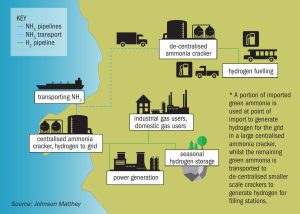
Fertilizer Industry News Roundup
BHP has approved an investment of $4.9 billion (CAD 6.4 billion) in stage two of its Jansen potash project (Jansen Stage 2) in Saskatchewan, Canada.

BHP has approved an investment of $4.9 billion (CAD 6.4 billion) in stage two of its Jansen potash project (Jansen Stage 2) in Saskatchewan, Canada.

Proman has signed a memorandum of understanding (MoU) with Mitsubishi Corp to collaborate on the development of a blue ammonia plant at Lake Charles, Louisiana. This new facility will aim to produce around 1.2 million t/a of low carbon ammonia, making it one of the largest of its kind in the world. The plant will incorporate carbon capture and sequestration technology. Proman says that this development aligns with the company’s commitment to sustainability and reducing greenhouse gas emissions. The proposed ammonia plant will be located at Proman’s existing site in Lake Charles, adjacent to its gas-to-methanol plant, which is also currently being developed.

CF Fertilisers UK Limited, a subsidiary of CF Industries, says that it plans to permanently close the ammonia plant at its Billingham fertilizer complex in order to secure the long-term sustainability of its business in the UK. The Company intends to continue to produce ammonium nitrate (AN) fertiliser and nitric acid at the Billingham site using imported ammonia, as it has for the last 10 months following its decision to temporarily idle the plant in August 2022.

Rohit Khurana and Umesh Jainker of KBR presented a technical paper on this topic during the 2013 Asian Nitrogen + Syngas Conference. It can be found in the UreaKnowHow.com E-Library with the title: ”Replacing ammonia plant catalyst with maximum efficiency and lowest cost”. The paper addresses the importance of de-dusting catalyst beds before commissioning and the serious impacts on the plant if not performed thoroughly. Many ammonia plants have faced problems related to the plugging of exchangers, pipe choking, pressure drop increase of the downstream catalyst beds and separators or foaming in the CO 2 removal section which could be caused by the presence of catalyst dust. Most of these problems have led to either decrease in the efficiency of the plant or operation at lower throughputs. The paper presents the critical steps and procedures for proper dedusting of the catalyst beds before commissioning. In addition, the foaming problem in the CO 2 removal section associated with catalyst dust is discussed signifying the importance of cleaning the CO 2 removal system and solution. The role of filters in the CO 2 removal section was also emphasised.

Prior to the covid pandemic, sub-Saharan Africa had been the fastest growing market for new fertilizer demand. However, the combination of pandemic related disruption, followed by the dislocations caused by the war in Ukraine, have pushed up prices and led to falling demand across the continent.

Venkat Pattabathula , a member of the AIChE Ammonia Safety Committee, reports on the American Institute of Chemical Engineers’ Safety in Ammonia Plants and Related Facilities Symposium, held in Munich, Germany, from 20-24 August 2023.

A review of recent additions to fertilizer product portfolios and new process technologies, as innovation within the industry accelerates to decarbonise production and improve nutrient use efficiency (NUE).
Maire SpA subsidiary Tecnimont, together with Orascom Construction SAE, have been awarded a lump sum turn-key engineering procurement and construction contract for new nitric acid and ammonium nitrate plants by the Egyptian Chemical Industries Company (‘Kima’). The contract value is approximately $300 million, of which about $220 million relates to Tecnimont activities. Finalisation of the contract is subject to successful execution of the financing package. The scope of work includes mainly engineering, supply of all materials and equipment – to be performed by Tecnimont – as well as construction activities, to be carried out by Orascom Construction.

Advances in clean hydrogen and ammonia production is fuelling worldwide interest in a new market for hydrogen and ammonia to provide a reliable low-carbon energy future. Ammonia cracking, the dissociation of ammonia back into hydrogen, delivers a pathway to large-scale sustainable hydrogen production. In this article KBR, Johnson Matthey, thyssenkrupp Uhde, Duiker, Proton Ventures and Casale report on their technologies and approaches to ammonia cracking in a low carbon economy.
Mining, metals and fertilizer business intelligence company CRU has launched a new low-emissions ammonia (LEA) price assessment in its Fertilizer Week price reporting service. The price takes a value-based approach, whereby a premium on the Northwest European ammonia price is calculated on an emissions-mitigated basis, and leverages CRU’s proprietary nitrogen asset emissions data combined with weekly European carbon prices to calculate the value of emissions mitigated. CRU says that it has leveraged its Emissions Analysis Tool to develop the premiums on an emissions-mitigated basis as opposed to a cost basis, allowing end-users to assess how the switch to LEA can deliver value to their business while contributing to their decarbonisation strategies. The Emissions Analysis Tool is a comprehensive asset-byasset emissions dataset for the nitrogen industry.